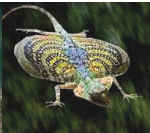Advertisements
Advertisements
Question
Identify the animal given in the picture and write features of its phylum/class.

Solution
The given organism is a flying lizard and belongs to class Reptilia.
Features of class Reptilia:
- Habitat: They are crawling animals. They are the first true terrestrial vertebrates. Few may be aquatic or semi-aquatic and are also found in marshy areas.
- Locomotion: Locomotion occurs by limbs in most animals. The limbs are pentadactyl with clawed digits, which help the animal to walk, creep or crawl. Snakes are limbless and crawl on their belly.
- Body temperature: They are poikilotherms.
- Exoskeleton: Skin is dry, non-glandular and covered by an exoskeleton of epidermal scales or scutes, shields or plates. Lizards and snake shed their skin periodically.
- Ear: Tympanum is present
- Circulatory system: It has two complete auricles but the ventricles are incompletely partitioned. Therefore, the heart of reptiles is not perfectly four-chambered (except in crocodile the heart is four-chambered).
- Nervous system: The brain is well developed. The olfactory lobes and cerebellum are better developed as compared to amphibians.
- Reproduction: Sexes are separate and exhibit prominent sexual dimorphism. Fertilization is internal and the animals are oviparous (exception - viper, it is viviparous). They show little parental care.
e.g. Naja naja (Cobra), Hemidactylus (Wall lizard), Chelonia (Turtle), Crocodilus (Crocodile), Testudo (Tortoise), Chameleon (Tree lizard), Bangarus (Krait), Vipera (Viper).
APPEARS IN
RELATED QUESTIONS
Choose the correct option.
In Ascaris, ___________.
Answer the following question.
Reptiles are known for having three-chambered heart. Which animal shows a near four-chambered condition in reptiles?
Answer the following question.
Pinna is part of the external ear and it is found in mammals. Do aves and reptiles show external ear in any form?
Answer the following question.
Birds need to keep their body light to help in flying. Hence, they show presence of some organs only on one side. How their skeleton helps in reducing their weight?
Answer the following question.
Cnidarians and Ctenophorans are both diploblastic. Which other character do they have in common, which is not found in other phyla?
Answer the following question.
Sponge and sea star show calcareous protective material. Do they belong to the same Phylum?
Draw a neat labelled diagram.
Sycon
Match the following.
| Phylum | Characters |
| i. Annelida | a. Tube feet |
| ii. Mollusca | b. Ostia |
| iii. Ctenophora | c. Radula |
| iv. Porifera | d. Parapodia |
| v. Echinodermata | e. Comb plates |
Identify the animal given in the picture and write features of its phylum/class.

Identify the animal given in the picture and write features of its phylum/class.

